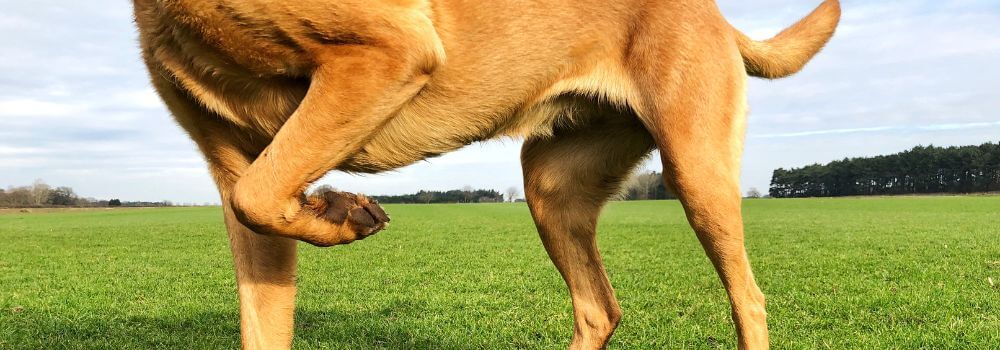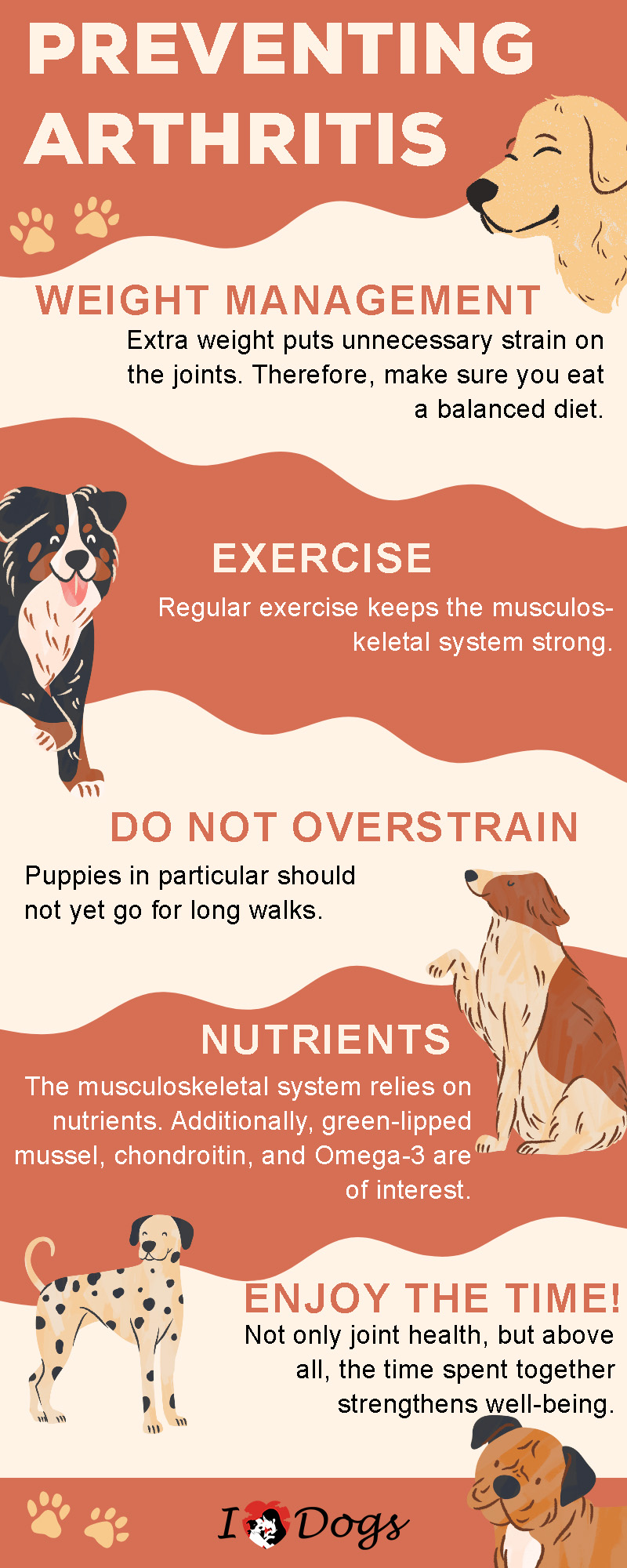Arthritis, an inflammatory joint disease, affects not only humans but also our faithful animal companions. The condition can cause pain, stiffness, and limited mobility in dogs. Today, we’ll reveal how to recognize arthritis in your dog and what you can do about it.
- What is Arthritis in Dogs?
- Symptoms of Arthritis in Dogs
- Causes of Arthritis in Dogs
- In 7 Steps to Diagnosis: Arthritis in Dogs
- Are there long-term effects of arthritis on my dog’s health?
- This is what the treatment for canine arthritis looks like
- Arthritis in Dogs: The Best Home Remedies
- Preventing Arthritis in Dogs: Play it Safe!
- Frequently Asked Questions (FAQ) about Arthritis in Dogs:
Key Points:
- Arthritis can affect both humans and dogs.
- Limping or stiffness are signs of the condition.
- Dog owners should always consult a veterinarian if there are concerns.
- The individual risk of arthritis is influenced by the immune system, infections, injuries, and genetic predisposition.
- A veterinarian can diagnose arthritis through a physical examination and possibly blood tests.
- There are various home remedies, such as heat applications, to alleviate symptoms in dogs.
- Dog owners often opt for supplements containing glucosamine and chondroitin. Both are found in our Petsana Joint Powder for Dogs.
- A healthy diet and regular gentle exercise are important.
What is Arthritis in Dogs?
Arthritis involves joint inflammation. This inflammation can occur for various reasons, including age-related wear and tear, genetic predisposition, or injuries. It results in the breakdown of protective cartilage in the joints, leading to pain, swelling, and stiffness.
You may have also heard of polyarthritis in relation to arthritis. Unlike regular arthritis, which can affect individual joints, polyarthritis affects multiple joints simultaneously.

Symptoms of Arthritis in Dogs
Arthritis in dogs can go unnoticed for a long time. Our four-legged friends often express their discomfort subtly. To address your companion’s needs and take early action, watch out for the following signs:
- Slower movements: If your energetic dog suddenly seems slower, it could be an early sign. Arthritis can make movements painful. Your dog might hesitate to stand up or climb stairs.
- Altered behavior: Your dog may appear less enthusiastic about activities it once loved. This could indicate joint pain due to arthritis.
- Limping or favoring a limb: Observe if your dog suddenly starts limping or favoring a limb, especially after resting or sleeping. This behavior could suggest initial difficulties in moving after longer periods of rest.
- Morning stiffness: Just like humans, dogs can be stiff in the mornings. If you notice your dog moving particularly sluggishly in the morning or needing your help to get going, it could indicate arthritis.
Causes of Arthritis in Dogs
Several factors can trigger arthritis and maintain inflammatory processes.
The Role of the Immune System:
A key factor in the development of arthritis in dogs is the immune system. It is suspected that in some dogs, the immune system mistakenly attacks the body’s own tissue, particularly in the joints. This can lead to an inflammatory response causing swelling, pain, and stiffness. The exact cause of this overactive immune response is not fully understood. Genetic predisposition and environmental factors could play a role.
Genetic Predisposition:
Just like humans, dogs can have a genetic predisposition to certain health conditions, including arthritis. Some breeds may be more prone to joint issues than others. For example, large breeds such as German Shepherds or Labrador Retrievers are more prone to joint problems like hip dysplasia, which could ultimately lead to arthritis.
Trauma and Injuries:
Injuries or traumas can also lay the groundwork for arthritis in dogs. When a joint is severely injured, it can lead to an inflammatory response that can eventually result in arthritis over time. This type of arthritis is often referred to as post-traumatic arthritis and can occur in dogs who have suffered injuries throughout their lives.
Infections:
Sometimes an infection, whether bacterial or viral, can cause the immune system to target the joints. This can lead to an inflammatory reaction that eventually results in arthritis. Although infections are not the most common cause of arthritis in dogs, it is still important to keep them in mind.
Environmental Factors:
The environment in which your dog lives can also influence the risk of arthritis. For example, obesity can strain the joints and increase the risk of arthritis. Similarly, certain dietary and exercise habits can affect joint health.
In 7 Steps to Diagnosis: Arthritis in Dogs
When your dog experiences joint discomfort, the veterinarian is the right person to consult. Through various measures, they can gain a comprehensive understanding of the situation and make a precise diagnosis. Early detection and proper treatment are key to improving your dog’s quality of life. So, if there are any concerns, always seek a veterinarian’s advice promptly.
Here’s how the veterinarian diagnoses arthritis in your dog:
- Clinical Examination: The veterinarian conducts a thorough physical examination of your dog to identify signs of pain, stiffness, or lameness.
- History: The veterinarian gathers information about your dog’s history, including previous injuries, illnesses, and behavioral changes.
- Imaging Techniques: X-rays can help assess the condition of the joints and reveal signs of arthritis such as swelling or tissue changes.
- Blood Tests: Blood tests can uncover inflammation markers and other signs of arthritis in the body.
- Joint Aspiration: In some cases, joint aspiration may be performed. The veterinarian takes a small amount of joint fluid for examination.
- Mobility Tests: Mobility tests are sometimes used to assess the range of motion and degree of pain in the affected joints.
- Exclusion of Other Causes: The veterinarian ensures that other possible causes of the symptoms are ruled out before confirming the diagnosis.
Good to know!
The veterinarian may not necessarily perform all the steps mentioned above for your dog. It may already be clear that your dog has arthritis even without joint aspiration.
Are there long-term effects of arthritis on my dog’s health?
In addition to restricted movement and behavior changes due to pain, arthritis can have other long-term consequences. Due to protective postures and reduced use of certain joints, muscle atrophy can occur. Muscle atrophy further impairs mobility. Untreated arthritis can worsen joint problems as inflammation and damage to joint cartilage progress. In the later stages, changes in posture may occur. Your dog may stand, walk, and lie down differently than before. Chronic pain can also increase the levels of stress hormones and affect overall well-being. So, if there are signs of arthritis, it’s essential to take action.
This is what the treatment for canine arthritis looks like
Together, we can help our dogs lead fulfilling and pain-free lives despite arthritis. Every dog is unique, so it’s important to tailor the treatment individually and work closely with the veterinarian to ensure the best possible care.
The following can help with arthritis:
- Medications: Veterinarians can prescribe pain relievers and anti-inflammatory medications to alleviate symptoms and reduce inflammation.
- Supplements: Substances like glucosamine and omega-3 fatty acids may support the joints and help improve mobility. How about trying our Petsana Joint Powder for Dogs?
- Weight Management: Excess weight puts additional strain on the joints. A balanced diet and regular exercise can help control weight and reduce pressure on the joints.
- Physical Therapy: Special exercises and physiotherapy can strengthen muscles and improve joint mobility.
- Adapted Exercise: Excessive strain is taboo. However, it’s important for dogs to exercise regularly to keep their joints in good condition.
- Aids: Special dog beds, stairs, or ramps provide more comfort and relief.
- Regular Veterinary Visits: Check-ups help ensure that the treatment is effective and can be adjusted if needed.
- Loving Care: Emotional support through cuddles and loving attention can positively influence the healing process. So, cuddling is definitely allowed!

Arthritis in Dogs: The Best Home Remedies
There are some home remedies that may help alleviate arthritis symptoms in dogs. However, it’s important to consult a veterinarian. After all, arthritis can be painful and requires professional medical care.
Here are some possible home remedies you can consider:
- Gentle Exercise: Light exercise can help mobilize the joints and strengthen muscles. Walks and controlled play can be helpful. Caution: Avoid excessive exertion!
- Comfortable Sleeping Area: Provide your dog with a comfortable and well-padded “bed” to minimize pressure on its joints during sleep.
- Warm Applications: Heat can help promote blood circulation and support muscle relaxation. You could use warm packs or heated dog beds.
- Omega-3 Fatty Acids: Omega-3 fatty acids have anti-inflammatory properties. They are found in fish oil and specific supplements.
- Glucosamine and Chondroitin: These substances are supposed to support cartilage in the joint. Both are contained in our Petsana Joint Powder for Dogs.
- Massage: Gentle massages can promote blood circulation and relax muscles. Make sure the massage is not painful and your dog enjoys it.
- Acupuncture: Some veterinarians offer acupuncture as a complementary therapy option for arthritis in dogs. This can help alleviate pain.
- Joint Protection: Avoid excessive strain on your dog’s joints. For example, avoid jumping from elevated surfaces.
Please note that these suggestions are general and may vary from case to case.
Preventing Arthritis in Dogs: Play it Safe!
Preventing arthritis in dogs is crucial for maintaining joint health and quality of life.
A balanced diet and weight control play an essential role. Excess weight puts additional strain on the joints, so keeping an eye on your dog’s weight is important. Regular exercise is also essential to strengthen muscles and support joints.
Especially in puppies, controlled growth is important to prevent future joint problems. Non-slip surfaces can help prevent falls and injuries on smooth floors. Joint-friendly activities are recommended to prevent excessive strain.
Comfortable sleeping areas with adequate padding relieve the joints during rest times. Regular veterinary check-ups enable early detection of possible issues. Supplements like glucosamine and omega-3 fatty acids may support joint health.
It’s important to watch out for signs of pain or stiffness in your dog. Early detection and treatment are crucial.
Paws crossed! Best wishes to you and your dog from the iHugDogsTeam!
Frequently Asked Questions (FAQ) about Arthritis in Dogs:
What is arthritis in dogs?
Arthritis is an inflammatory joint disease that can occur in dogs. It leads to pain, stiffness, and limitations in mobility.
What symptoms indicate arthritis?
Typical signs include lameness, stiffness after rising, reduced activity, difficulty climbing stairs, and signs of pain such as whining.
Can I help my dog with arthritis with home remedies?
Some home remedies such as warm compresses, comfortable sleeping areas, and certain supplements may provide relief. However, it’s important to consult the veterinarian first.
How can I prevent arthritis in my dog?
Healthy nutrition, controlled growth in puppies, regular exercise, avoiding injuries, and regular veterinary check-ups are important preventive measures.
What role does my dog’s weight play?
Excess weight puts additional strain on the joints and can increase the risk of arthritis. Healthy weight control is therefore crucial.
Can my dog still be active despite arthritis?
Yes, moderate exercise is important to strengthen muscles and joints. However, talk to your veterinarian to find the right balance.
Are there medications for arthritis in dogs?
Yes, veterinarians can prescribe anti-inflammatory medications, pain relievers, and other therapy options to alleviate symptoms.
Can arthritis be cured?
Arthritis is usually not curable, but with proper treatment and management, symptoms can be reduced, and the dog’s quality of life can be improved.
Which breeds are more susceptible to arthritis?
Large breeds, especially those with long backs or large joints, tend to be more susceptible to joint problems like arthritis.
When should I take my dog to the vet?
If you notice signs of pain, stiffness, or behavioral changes, you should take your dog to a veterinarian for a thorough diagnosis and appropriate treatment.
Can I give my dog supplements like glucosamine?
Yes, glucosamine and other supplements can be given, but it’s advisable to consult with a veterinarian before use.
How can I help my dog if he already has arthritis?
Your veterinarian can assist you in developing an individualized treatment plan, which may include medication, physical therapy, and lifestyle changes.


